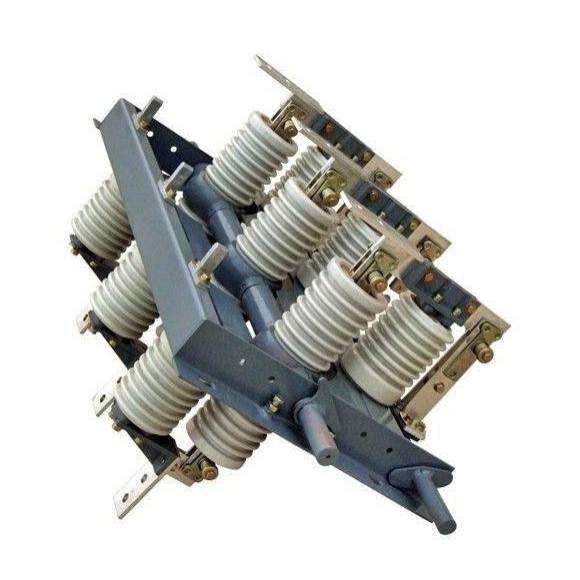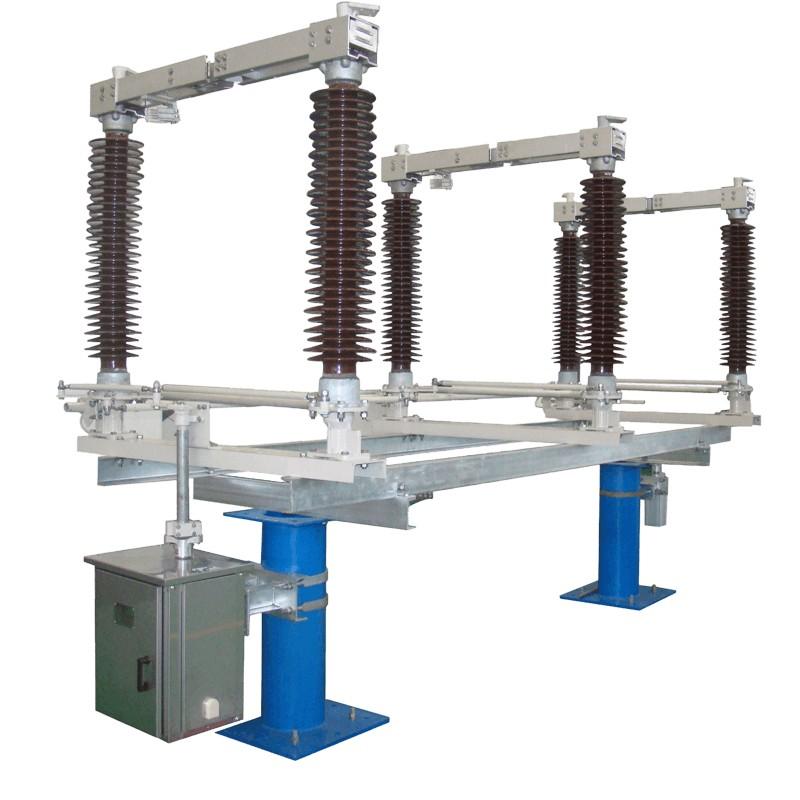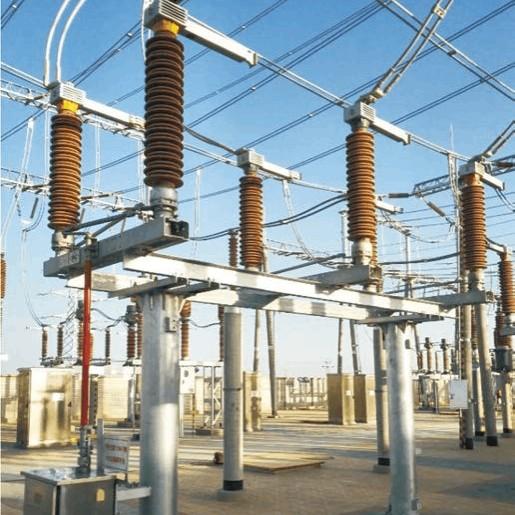1.Description of the Fault Phenomenon
The disconnector fault in a 550 kV GIS equipment occurred at 13:25 on August 15, 2024, while the equipment was operating under full load with a load current of 2500 A. At the moment of failure, the associated protection devices acted promptly, tripping the corresponding circuit breaker and isolating the faulty line. System operating parameters changed significantly: the line current dropped abruptly from 2500 A to 0 A, and the bus voltage instantly decreased from 550 kV to 530 kV, fluctuating for approximately 3 seconds before gradually recovering to 548 kV and stabilizing. On-site inspection by maintenance personnel revealed obvious damage to the disconnector. A burn mark approximately 5 cm long was found on the surface of the insulating bushing. A discharge scorch spot about 3 cm in diameter appeared at the connection between the moving and fixed contacts, surrounded by black powdery residue, and some metal components showed signs of melting, indicating intense arcing during the fault.
2.Fault Cause Analysis
2.1 Analysis of Basic Equipment Parameters and Operating Conditions
The disconnector has a rated voltage of 550 kV, a rated current of 3150 A, and a breaking current of 50 kA. These parameters meet the operational requirements of the 550 kV system at this substation, theoretically ensuring reliable operation under normal conditions. The disconnector had been in service for 8 years with 350 operations. The most recent maintenance was performed in June 2023, including contact polishing, lubrication, mechanism adjustment, and insulation resistance testing—all results met specifications at that time. Although the number of operations was within normal range, long-term operation may have introduced aging risks, potentially leading to latent defects during subsequent service.
2.2 Electrical Performance Test Analysis
Insulation resistance testing of the disconnector showed an inter-contact insulation resistance of 1500 MΩ (historical value: 2500 MΩ; standard requirement: ≥2000 MΩ). The ground insulation resistance was 2000 MΩ (historical value: 3000 MΩ; standard requirement: ≥2500 MΩ). Both values were significantly lower than historical data and standards, indicating degraded insulation performance.
Dielectric loss factor (tanδ) testing at 10 kV yielded a measured value of 0.8% (historical value: 0.5%; standard requirement: ≤0.6%). The elevated tanδ suggests possible moisture ingress or aging of the insulation medium, which reduces insulation strength and increases the risk of dielectric breakdown.
2.3 Mechanical Performance Test Analysis
Contact pressure measurements showed:
Phase A: 150 N (design value: 200 N, deviation: –25%)
Phase B: 160 N (deviation: –20%)
Phase C: 140 N (deviation: –30%)
All measured contact pressures were below design values with large deviations, likely causing increased contact resistance, localized overheating, and arcing.
Operational mechanism analysis revealed:
Closing time: 80 ms (design range: 60–70 ms); synchronism deviation: 10 ms (design limit: ≤5 ms)
Opening time: 75 ms (design range: 55–65 ms); synchronism deviation: 12 ms (design limit: ≤5 ms)
Both opening/closing times exceeded design limits, and synchronism deviations were excessive, indicating mechanism malfunction that could cause asynchronous contact/separation, leading to arc reignition and discharge.
2.4 Comprehensive Fault Cause Analysis
Integrating all findings:
Electrically, reduced insulation resistance and increased tanδ indicate deteriorated insulation, creating conditions for breakdown.
Mechanically, insufficient contact pressure caused poor contact and localized heating, while abnormal mechanism performance led to asynchronous operation and arc reignition, exacerbating insulation damage.
Although regularly maintained, long-term service exposed the equipment to aging, and environmental factors such as temperature and humidity fluctuations further degraded performance. The disconnector’s flashover fault resulted from the combined effects of insulation degradation, mechanical anomalies, and equipment aging.
3.Fault Handling Measures
3.1 On-Site Emergency Response
Immediately after the flashover fault, an emergency response protocol was activated to ensure grid safety. The faulty disconnector was isolated by tripping associated circuit breakers, preventing fault escalation. Protection devices linked to the disconnector were inspected and adjusted to avoid maloperation or failure. System operation mode was urgently reconfigured: load previously carried by the faulty line was smoothly transferred to healthy lines to maintain power supply to critical users. During this process, system parameters (voltage, current, frequency) were closely monitored to ensure stable operation. Personnel were assigned to secure the fault site and prevent unauthorized access, avoiding secondary incidents.
3.2 Equipment Repair Plan
Based on root cause analysis, a detailed repair plan was developed:
For degraded insulation: replace and restore insulation media. Remove damaged, moist, or aged insulation materials and install new, compliant materials to restore insulation performance.
For insufficient contact pressure: inspect and replace contact springs, adjust contact pressure to design values to minimize contact resistance and prevent overheating/arcing.
For mechanism faults: replace damaged components and fully recalibrate the mechanism to meet design specifications for timing and synchronism.
3.3 Repair Process and Key Technical Points
Repairs strictly followed the plan. The disconnector was fully disassembled for thorough inspection to confirm damage extent. During insulation replacement, ambient humidity and temperature were controlled to prevent contamination or moisture absorption of new materials. Installation ensured precise positioning and tight bonding of insulation to avoid voids or looseness. Contact pressure adjustments used calibrated tools for accurate, uniform force across all phases. Mechanism reassembly and calibration adhered to procedures to guarantee smooth, reliable operation. After repair, comprehensive tests were conducted—insulation resistance, tanδ, contact pressure, and mechanism performance—all meeting standards before re-energization.
4.Verification of Repair Effectiveness
4.1 Post-Repair Testing
Comprehensive tests confirmed restored performance (see Table 1):
Insulation resistance: inter-contact increased from 1500 MΩ to 2400 MΩ; ground resistance rose from 2000 MΩ to 2800 MΩ—both meeting standards.
tanδ decreased from 0.8% to 0.4%, within acceptable limits, confirming resolution of moisture/aging issues.
Withstand voltage test: pre-repair breakdown occurred at 480 kV (< standard); post-repair, no breakdown at 600 kV—validating insulation recovery.
| Test Item |
Data Before Repair |
Data After Repair |
Standard Value |
Qualified or Not |
| Insulation Resistance (MΩ) |
Between moving and static contacts: 1500To ground insulation: 2000 |
Between moving and static contacts: 2400To ground insulation: 2800 |
Between moving and static contacts: ≥2000To ground insulation: ≥2500 |
Yes |
| Dielectric Loss Tangent tanδ (%) |
0.8 |
0.4
|
≤0.6 |
Yes |
| Withstand Voltage Test (kV) |
Breakdown occurred at the specified test voltage, breakdown voltage was 480kV |
No breakdown occurred at the specified test voltage of 600kV |
≥600kV |
Yes |
4.2 Operational Monitoring and Evaluation
The repaired disconnector underwent 3 months of operational monitoring. Contact temperatures remained normal, confirming effective contact pressure adjustment and controlled contact resistance. Switching operations stabilized: closing time at 65 ms, opening at 58 ms, with synchronism deviations ≤3 ms. No arc reignition or discharge occurred. Combined test and monitoring results confirm successful fault resolution and stable operation.
5.Preventive Measures and Recommendations
To ensure efficient GIS operation and reduce fault risks, strict maintenance strategies must be implemented:
Regular inspections: Conduct weekly visual checks and monthly functional tests by qualified teams to detect damage or anomalies early.
Advanced condition monitoring: Deploy online monitoring systems for real-time tracking of partial discharge, temperature, and gas composition to identify potential issues proactively.
Preventive testing: Perform periodic insulation resistance and tanδ tests to assess electrical/insulation health and prevent aging or moisture-related failures.
Equipment selection & installation: Choose proven, mature GIS equipment meeting operational needs. Strictly adhere to design and construction standards during installation to ensure proper alignment and secure connections.
Commissioning: Rigorously verify all performance parameters during commissioning, documenting all data for future maintenance reference.
Personnel training: Regularly conduct technical training and emergency drills to enhance staff proficiency in operation and fault handling, ensuring rapid, effective responses to incidents and safeguarding grid stability.
6.Conclusion
This paper presents a successful analysis and resolution of a flashover fault in a 550 kV GIS disconnector. Detailed fault documentation and multi-dimensional testing accurately identified root causes. Implemented emergency response and repair measures effectively resolved the issue, validated by post-repair tests and operational monitoring. Proposed preventive measures are targeted and practical, offering valuable guidance for GIS maintenance. Future work should deepen research into GIS fault mechanisms to further enhance power system security and reliability.


























